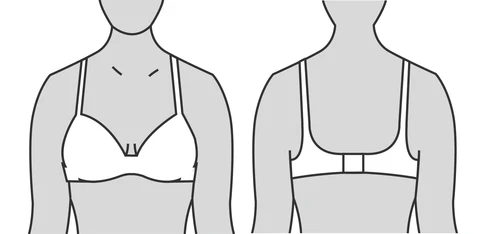For many women, wearing a bra is part of everyday life. But what if that very piece of clothing, meant to support you, is actually doing more harm than good? An ill-fitting bra doesn’t just cause minor irritation—it can lead to significant posture problems, chronic pain, and long-term health issues.
Sadly, studies suggest that as many as 8 out of 10 women are wearing the wrong bra size. That’s a staggering number considering how deeply the effects can be felt. Professional recommend going for only the best bra brand when it comes to buying bras to invest in your health.
So how can you tell if your bra is doing more harm than good? And what exactly are the risks of wearing the wrong one?
Tell-Tale Signs Your Bra Isn’t Correctly Fitted
Before diving into the health consequences, it’s important to recognize the signs of a poorly fitting bra. Often, discomfort becomes so normalized that many women don’t even realize their bra is the problem.
Here are a few red flags:
The band rides up at the back: This is one of the most common signs. The band should sit straight and firm across your back—not inching upward. If it’s riding up, your band is likely too loose, forcing your straps to take on too much weight.
- Shoulder straps are digging in: Straps should provide about 10–20% of the support. If they’re digging into your shoulders, it’s a sign your band isn’t doing its job, and your shoulders are bearing too much strain.
- The center of the bra (the gore) doesn’t sit flush with your sternum: If the center panel lifts off your chest, your cups might be too small or the wrong shape for your bust.
- Cup spillage or gaping: Your breasts should sit comfortably within the cups. Spillage over the top or sides indicates too small a cup, while gaping suggests the cup is too big.
- You’re constantly adjusting: If you find yourself tugging at your straps, shifting your band, or fixing your cups throughout the day, something’s off.
When a bra doesn’t fit well, the effects go far beyond fashion or inconvenience.
Consequences of Wearing the Wrong Bra
1. Breast Pain
Breast pain, also known as mastalgia, can be triggered by inadequate support. When breasts—especially larger ones—aren’t properly supported, the constant movement puts strain on the ligaments (Cooper’s ligaments), causing soreness and discomfort. This can intensify during physical activity or over a long workday.
2. Back Pain
If your bra isn’t supporting your bust properly, the muscles in your back work overtime to compensate. This can lead to upper and lower back pain, particularly for full-busted women. Poor support can cause the shoulders to round forward, further stressing the spine and muscles.
3. Skin Abrasions and Chafing
Tight straps, loose bands, and ill-fitting cups can cause friction against your skin. This leads to redness, rashes, and even broken skin over time. Underwires that poke or dig into your sides are a common culprit as well.
4. Shoulder and Neck Pain
When shoulder straps are forced to bear more weight than they’re designed for—because the band is too loose—tension builds in the shoulders and neck. This can result in headaches, shoulder strain, and stiff neck muscles, especially if worn daily.
5. Premature Sagging
Contrary to popular belief, wearing a bra doesn’t prevent sagging—but wearing the wrong one might accelerate it. Without proper support, breast tissue and ligaments can stretch prematurely, especially in larger breasts. This contributes to a loss of firmness and natural shape over time.
6. Bad Posture and General Discomfort
Over time, a bad bra can affect your posture significantly. You may unconsciously hunch to relieve strap pressure or tilt your shoulders forward because the support is lacking. Poor posture not only affects how you look and feel—it can also lead to long-term issues with spinal alignment and reduced mobility.
Wearing an uncomfortable or ill-fitting bra can also cause mental fatigue. Constant adjustments, nagging discomfort, and even self-consciousness about appearance all take a toll on your mood and confidence.
Why Getting Professionally Fitted Matters
If you haven’t been professionally fitted for a bra in over a year—or ever—it’s time. A proper bra fitting takes your full bust, band, and cup shape into consideration, and many reputable lingerie stores offer this service for free. A professional can help you find not just the right size, but also the best styles and structures for your body.
Remember, bra sizes can fluctuate due to:
- Weight gain or loss
- Hormonal changes (e.g. pregnancy, menopause, menstrual cycle)
- Aging and natural shifts in breast tissue
- Lifestyle changes (exercise, diet, posture)
Getting fitted isn’t a one-and-done event. Your body changes, and your bras should change with it.
Final Thoughts
Your bra should support you—literally and figuratively. When it fits well, it improves your posture, reduces pain, and boosts your confidence. But when it doesn’t, it can wreak havoc on your body in ways many women don’t even realize until the damage is done.
If any of the signs above sound familiar, it’s time to take a closer look at your lingerie drawer. Prioritize comfort and support over appearance alone, and invest in bras that fit your body. Getting a proper fitting and understanding your size and shape can transform not only how you feel in your clothes, but how you carry yourself every day.
Because the right bra isn’t just about fashion—it’s about your health.
